Did you know that 73% of smartphone users are concerned about their devices being hacked? If you want to protect your electronic devices from hacking, tracking, and electromagnetic interference, then Faraday bags are your solution. But what exactly are Faraday bags made of?
Faraday bags are made of materials designed to block electromagnetic signals effectively. The primary components include a conductive fabric or metal mesh, an insulating layer made of materials like nickel or copper, and an inner lining for additional reinforcement.
This article will explore the composition of Faraday bags, industry standards, DIY options, and tips for selecting the best one for your devices.
What Are Faraday Bags?
Faraday bags are specialized containers made of materials that block electromagnetic signals, preventing electronic devices from receiving or transmitting data.
Historically, they were used by scientists like Michael Faraday to conduct experiments with electricity and magnetism.
Constructed from specialized materials, faraday bags have been used to shield electronic devices from interference for security and privacy purposes. These bags have evolved over time to meet modern applications, providing a reliable solution for protecting sensitive information.
The material composition of faraday bags typically includes layers of conductive fabric or metal mesh that create a barrier against electromagnetic fields. This design effectively blocks incoming and outgoing signals, ensuring that devices inside remain secure from potential hacking or tracking attempts.
While some individuals opt for DIY construction of Faraday cages using household items, commercially available Faraday bags offer a more reliable solution. They are professionally crafted to safeguard electronic devices in various settings.
When are Faraday Bags Essential?
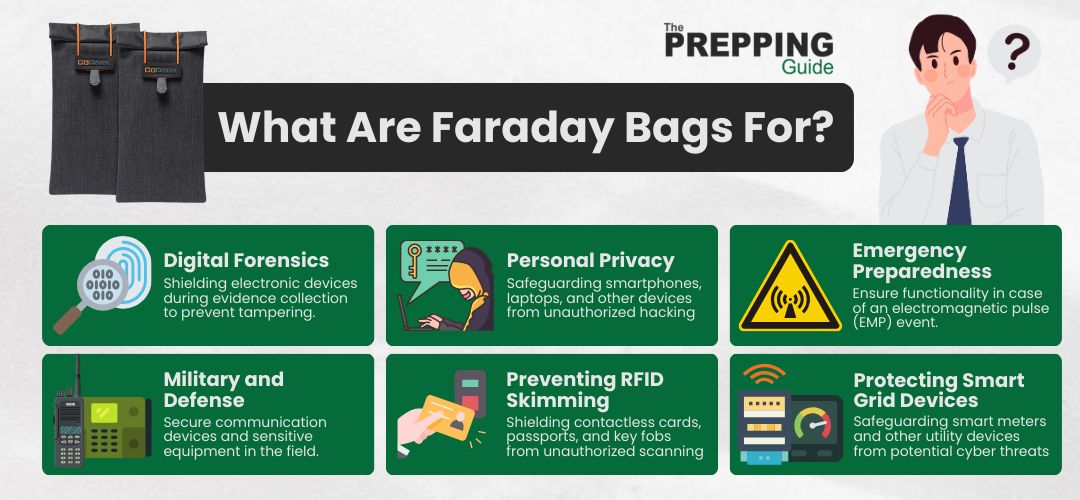
Faraday bags prove to be essential in safeguarding electronic devices and sensitive information in various scenarios where protection against electromagnetic interference is crucial.
One significant application is in the field of digital forensics, where maintaining the integrity of electronic evidence is paramount. By placing devices inside Faraday bags during collection and transportation, forensic investigators prevent potential tampering or unauthorized access, ensuring the reliability of the gathered evidence.
These protective bags have also become indispensable for personal privacy, especially in the age of increasing cyber threats. Individuals can utilize Faraday bags to shield their smartphones, laptops, and other electronic gadgets from potential hacking attempts or tracking activities. This becomes particularly relevant during travel or public events where the risk of unauthorized access is heightened.
Faraday bags are a practical solution to control one’s digital footprint and protect against potential privacy breaches.
Moreover, the importance of Faraday bags extends to emergency preparedness, as they offer a reliable means to secure essential electronics in the event of an electromagnetic pulse (EMP) incident. By mitigating the impact of electromagnetic radiation on devices stored within the bags, individuals can ensure the functionality of critical equipment and communication tools during unforeseen circumstances.
The Science Behind Faraday Bags
Faraday bags operate on the principle of the Faraday Cage, which is a conductive enclosure that blocks electromagnetic fields. The materials used in Faraday bags are crucial for their effectiveness in blocking these fields and protecting electronic devices.
In this video, a retired FBI supervisory special agent conducts three tests to evaluate the Faraday bag’s signal blocking capabilities. The testing used an iPhone and an RF Transmitter.
The Faraday Cage Principle
Based on the Faraday Cage principle, faraday bags are designed to block electromagnetic signals and prevent electronic devices from receiving or transmitting data. These bags use conductive materials like copper or nickel to create a shield surrounding the device.
The shielding effectiveness of a faraday bag is determined by its ability to block different frequencies of electromagnetic radiation. By containing the device within this shielded environment, the signal-blocking properties of the Faraday bag ensure that no external signals can penetrate through, keeping your electronics safe from hacking or tracking attempts.
This technology has various applications in cybersecurity, law enforcement, and personal privacy protection, making faraday bags an essential tool for anyone looking to secure their devices from unwanted electromagnetic interference.
How Electromagnetic Fields Are Blocked
Electromagnetic fields are blocked by using conductive materials to create a shield around electronic devices. This process, known as electromagnetic shielding, prevents signal interference and protects sensitive equipment from radio frequency emissions.
The shield acts as a barrier that absorbs and redirects electromagnetic energy, ensuring data protection and maintaining the integrity of electronic signals. The effectiveness of the shielding is crucial in preventing outside signals from penetrating the device and causing disruptions.
By utilizing materials with high conductivity, Faraday bags can effectively block electromagnetic fields and provide a secure environment for electronic devices to operate without interference.
Relationship Between Materials and Effectiveness
Material conductivity determines how well a faraday bag can shield your equipment from unwanted signals.
High-conductivity materials are essential for achieving optimal shielding performance. When evaluating the effectiveness of a faraday bag, consider factors such as fabric thickness, metal durability, and overall shielding performance.
Thicker fabrics offer better protection, while durable metals ensure long-lasting shielding capabilities.
Materials Used in Faraday Bags
Faraday bags are typically made using conductive fabrics that help to block electromagnetic signals from reaching the devices inside. These fabrics are woven with metal mesh, such as copper or nickel coatings, to create a barrier against unwanted radio waves.
Conductive Fabrics
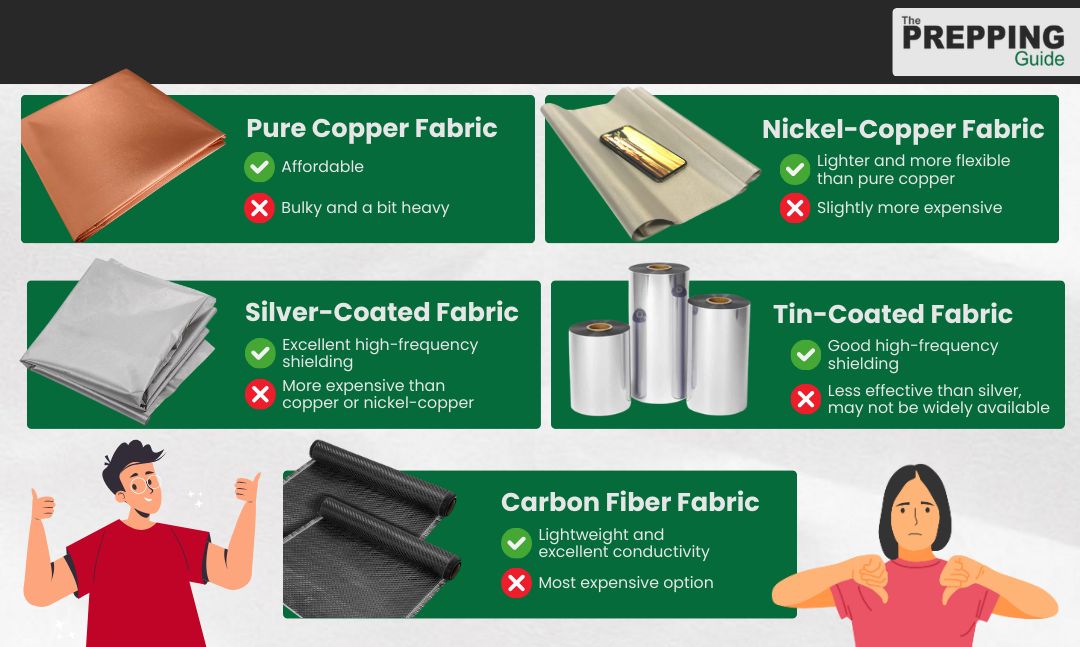
Conductive textiles are essential due to their fabric composition, which enhances their blocking capabilities compared to other materials used in Faraday bags.
When considering Faraday bag materials, conductive fabrics stand out for their durability and reliability in maintaining signal isolation. Using metal mesh within these fabrics provides flexibility while maintaining high effectiveness in shielding electromagnetic fields.
Choose quality materials like conductive fabrics for optimal performance.
Metal Mesh
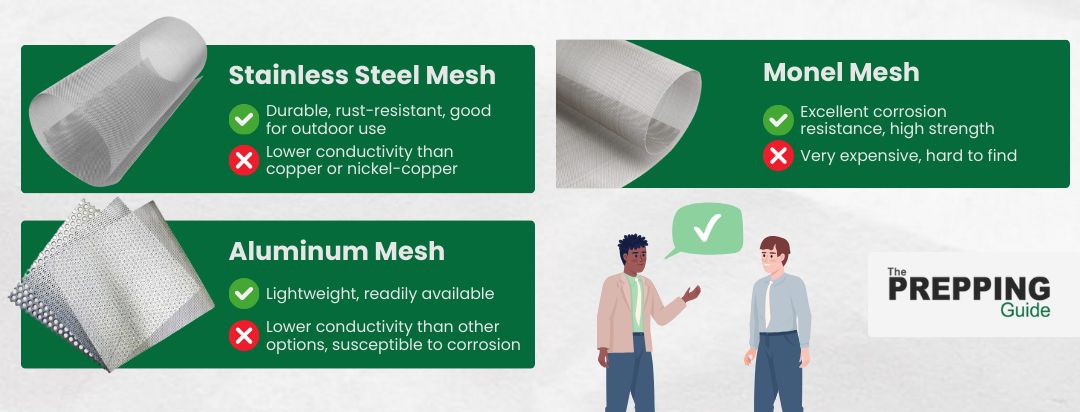
Metal mesh, often used in shielding applications, has been found to block up to 99% of electromagnetic signals, making it a highly effective material for protecting electronic devices. The mesh’s durability ensures long-lasting protection against various external factors, while its conductive properties effectively redirect harmful signals away from the enclosed items.
Additionally, the flexibility of metal mesh allows for easy storage and handling, making it a convenient choice for faraday bags. Compared to other materials, metal mesh stands out due to its superior conductivity and efficiency in blocking electromagnetic interference.
Its high level of conductivity ensures that electronic devices remain safe from potential damage caused by external signals.
Copper and Nickel Coatings for Faraday Fabrics
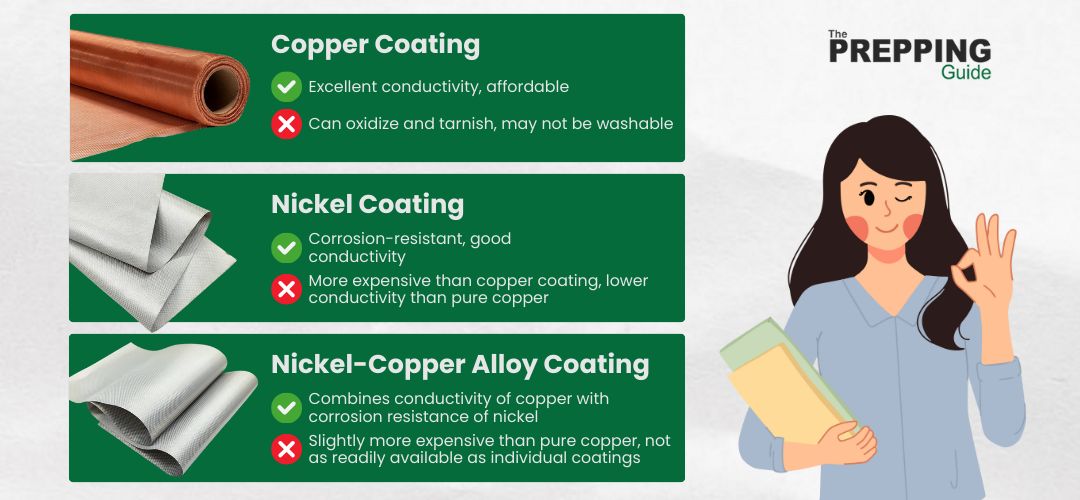
Copper and nickel coatings are known for their ability to provide excellent electromagnetic shielding for electronic devices. The conductive properties of these coatings make them ideal for protecting sensitive equipment from unwanted interference.
In the manufacturing process, copper and nickel are applied as thin layers onto the surface of faraday bags through a specialized plating technique. This ensures that the material composition is uniform and provides consistent shielding effectiveness.
Furthermore, these coatings also offer anti-static properties, preventing any build-up of static electricity that could damage electronics. Overall, copper and nickel coatings are essential in creating faraday bags that effectively block out external electromagnetic signals while keeping your devices safe and secure.
Comparing Faraday Bag Materials
When comparing Faraday bag materials, you’ll find two common primary types: conductive fabric and metal mesh.
Conductive Fabric vs. Metal Mesh
For optimal protection against electromagnetic signals, opt for a faraday bag made of conductive fabric rather than metal mesh.
Conductive fabric offers higher material conductivity, resulting in better shielding effectiveness than metal mesh. The fabric’s flexibility allows for easy storage and transportation of electronic devices while maintaining the integrity of the signal-blocking capabilities.
On the other hand, metal mesh may provide durability but lacks shielding effectiveness. This is due to potential gaps or weak points in the structure. Additionally, conductive fabric generally outperforms metal mesh regarding coating comparison, ensuring consistent and reliable protection against electromagnetic interference.
Copper vs. Nickel Coatings
Copper, known for its superior conductivity compared to aluminum coatings, offers excellent signal blocking capabilities due to its high shielding effectiveness. The thickness variations of copper coatings significantly enhance the overall shielding performance by providing a robust barrier against electromagnetic interference.
On the other hand, nickel coatings may offer slightly lower conductivity than copper but maintain good shielding effectiveness. Understanding the differences in conductivity and shielding properties between copper and nickel coatings is crucial in selecting the most suitable material for Faraday bags based on specific needs and requirements.
This consolidated table provides a comparison of conductive fabrics, metal meshes, and copper and nickel coatings concerning key criteria relevant to Faraday bags.
| Criteria | Conductive Fabric | Metal Mesh | Copper Coating | Nickel Coating |
| Conductivity | High conductivity | Excellent conductivity | Excellent conductivity | Very good conductivity |
| Corrosion Resistance | Depends on material (e.g., silver-coated) | Good corrosion resistance (e.g., stainless steel) | Moderate corrosion resistance | Good corrosion resistance |
| Cost | Can vary | Moderate to high | Generally more affordable than nickel | Moderately priced |
| Applications | Commonly used in wearable tech, flexible electronics | Widely used in Faraday bags, larger shielding applications | Commonly used in various electronic components | Used in electronic components and electromagnetic shielding |
Factors Influencing Faraday Bag Material Selection
When selecting materials for your Faraday bag, you must consider factors such as frequency blocking capabilities, durability, and flexibility. The material’s ability to block a wide range of frequencies is crucial in ensuring complete protection for your electronic devices.
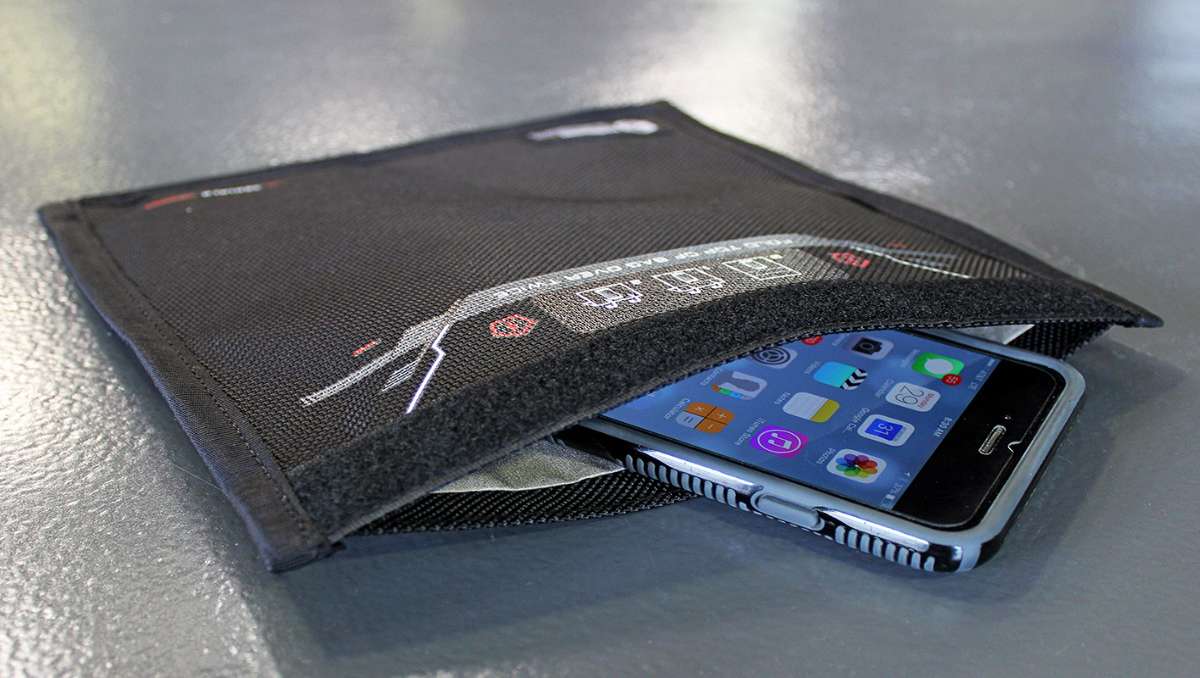
Frequency Blocking Capabilities
The frequency-blocking capabilities of materials are a crucial factor in choosing the right material for Faraday bags. They directly impact the bag’s effectiveness in shielding electronic devices from electromagnetic interference. Different materials exhibit varying levels of effectiveness at blocking specific frequencies.
For example, some bags may need to block mobile phones or Wi-Fi signals, while others might need to shield against RFID frequencies. Understanding the intended use case helps select materials with optimal frequency blocking capabilities.
Faraday bags designed for comprehensive electromagnetic protection should exhibit effectiveness across various frequencies. This is particularly important in scenarios where the bag needs to shield against mixed communication signals.
Flexibility and Ease of Use
Regarding material options, these bags are typically made of durable materials like high-quality fabric or synthetic materials that ensure long-lasting device protection.
The portability factor is essential, as faraday bags are designed to be compact and lightweight for easy transportation.
Their user-friendly design allows quick and convenient access to your devices while maintaining security.
Some Faraday bags offer customization possibilities, such as different sizes or colors to suit individual preferences.
It’s worth noting that while these bags provide excellent protection against electromagnetic signals, they may impact signal strength when your device is inside.
Industry Standards and Certifications
Faraday bags must meet specific requirements to ensure the protection of electronic devices from electromagnetic interference. The materials used in faraday bags must adhere to strict guidelines set by organizations such as the National Institute of Standards and Technology (NIST).
Certifications play a crucial role in validating the effectiveness of faraday bags in shielding electronic devices. Look for bags tested and certified by reputable third-party labs to ensure they meet industry standards for electromagnetic compatibility (EMC). Common certifications include CE marking, RoHS compliance, and MIL-STD-188-125 certification.
Make sure to look for these key certifications when selecting a faraday bag for your needs.
Making a DIY Faraday Bag
Create your own protective enclosures for electronic devices using simple materials found at home. When it comes to DIY options for Faraday bags, there are various materials you can use to construct these shielding enclosures.
One effective method involves using aluminum foil, which is readily available in most households. Simply wrap your device in several layers of aluminum foil to create a makeshift Faraday bag.
For a more durable solution, consider using Mylar or anti-static bags found online or at electronic stores. These materials provide better shielding against electromagnetic interference compared to aluminum foil. To enhance the effectiveness of your homemade Faraday bag, make sure there are no gaps or openings where signals could penetrate.
Experiment with different shielding techniques and methods to see what works best for your needs. Custom designs can also be practical depending on the size and shape of your electronic devices.
If you want to make your own simple Faraday bag at home, follow the following steps:

Tips for Choosing the Right Faraday Bag
Selecting a Faraday bag that can accommodate your specific needs is important to ensure all your devices are shielded effectively.
Consideration of Device Size and Quantity
Device compatibility is crucial to ensure a proper fit and protection effectiveness. Consider the size of your devices to ensure they’ll fit securely inside the bag without being too cramped or loose. Quantity limitations should also be considered as some Faraday bags are designed to hold multiple devices while others are meant for just one.
Keep in mind that signal interference can occur if devices are packed too closely together, so choose a bag that provides enough space between each device.
Compatibility with Different Electronic Devices
Consider the variety of electronic devices you own and how well they’ll be shielded within the chosen faraday bag. Device protection is crucial when it comes to signal interference and signal isolation.
Different devices may require different levels of electronic security, so it’s essential to ensure that your faraday bag is compatible with all your gadgets.
Whether you have a smartphone, tablet, laptop, or even a key fob that needs protection, make sure the faraday bag can accommodate them all without compromising on shielding effectiveness.
This compatibility factor plays a significant role in safeguarding your devices from potential cyber threats and unauthorized access. Choose a faraday bag that meets the specific requirements of each device for optimal protection.
You might also be interested to learn about budget bug out bags.
Wrapping Up
In conclusion, when considering what Faraday bags are made of, it’s crucial to understand the science behind their purpose.
The materials used in Faraday bags play a vital role in their effectiveness in blocking electromagnetic signals.
Factors such as conductivity and durability should be taken into account when selecting the right material for your needs.
Remember, choosing the right Faraday bag is like finding a needle in a haystack. Make sure you do your research to protect your devices effectively.
